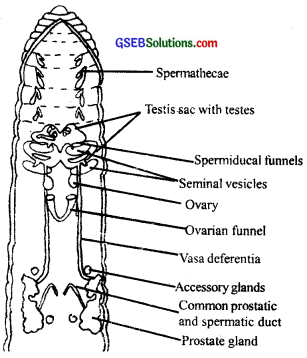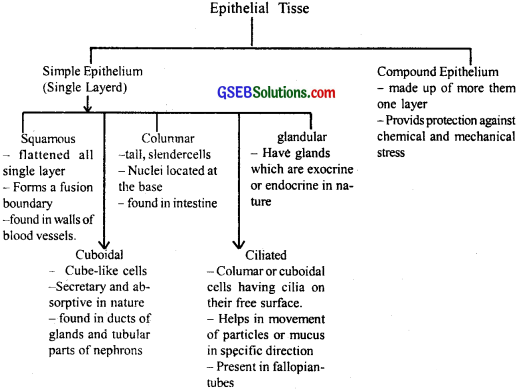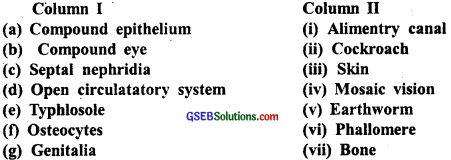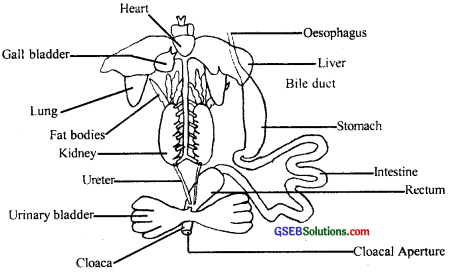Gujarat Board GSEB Textbook Solutions Class 11 Biology Chapter 7 Structural Organisation in Animals Textbook Questions and Answers.
Gujarat Board Textbook Solutions Class 11 Biology Chapter 7 Structural Organisation in Animals
GSEB Class 11 Biology Structural Organisation in Animals Text Book Questions and Answers
Question 1.
Answer in one word or one line.
(i) Give the common name of Periplaneta Americana.
Answer:
Cockroach
(ii) How many spermathecae are found in earthworms?
Answer:
Two
(iii) What is the position of ovaries in cockroaches?
Answer:
2 large ovaries are found lying laterally in the 2nd to 6th abdominal segment.
(iv) How many segments are present in the abdomen of the cockroach?
Answer:
Ten segments.
(v) Where do you find Malpighian tubules?
Answer:
Malpighian tubules are the main excretory organs of the cockroach.
![]()
Question 2.
Answer the following:
- What is the function of nephridia?
- How many types of nephridia are found in earthworms based on their location?
Answer:
1. Nephridia regulate the volume and composition of the body fluids. A nephridium starts out like a funnel that collects excess fluid from the coelomic chamber. The funnel connects with a tubular part of the nephridium which delivers the wastes through a pore to the surface in the body wall into the digestive tube.
2. Nephridia are of three types:
- Septal nephridia, present on both the sides of intersegmental septa of segment 15 to the last that open into the intestine
- Integumentary nephridia, attached to the lining of the body wall of segment 3 to the last that open on the body surface and
- Pharyngeal nephridia, present as three paired tufts in the 4th, 5th, and 6th segments. These different types of nephridia are basically similar in. structure.
![]()
Question 3.
Draw a labeled diagram of the reproductive organs of an earthworm.
Answer:

Question 4.
Draw a labeled diagram of the alimentary canal of a cockroach.
Answer:

Question 5.
Distinguish between the followings:
(a) Prostomium and peristomium
Answer:
The prostomium is the front most part of the earthworm. This is not called a true segment as it doesn’t contain typical organs of an Annelida. Peristomium is from where the true segment of the earthworm body starts.
(b) Septal nephridium and pharyngeal nephridium
Answer:
Septal nephridia, present on both sides of intersegmental septa of segment 15 to the last open into the intestine. Pharyngeal nephridia, present as three paired tufts in the 4th, 5th, and 6th segments. Both are the same structurally and functionally.
![]()
Question 6.
What are the cellular components of blood?
Answer:
Blood is a fluid connective tissue containing plasma, red blood cells, white blood cells, and platelets.
Question 7.
What are the following and where do you find them In the animal body.
(a) Chondrocytes
Answer:
Cells of cartilage
(b) Axons
Answer:
Taillike the structure of a neuron
(c) Ciliated epithelium
Answer:
Found in the inner lining of bronchioles. Cilia help trap and clear dust foreign particles.
![]()
Question 8.
Describe various types of epithelial tissue with the help of labeled diagrams.
Answer:


Question 9.
Distinguish between
(a) Simple epithelium and compound epithelium
Answer:
Simple epithelium is composed of one layer of cells while compound epithelium is composed of more than one layer of cells.
(b) Cardiac muscle and striated muscle
Answer:
Cardiac muscles are present in the cells of the heart only. They have a contractile property which helps in”the pumping action of the heart. Striated muscles are present near articulatory joints. Their role is to facilitate the movement of organs like hands and feet.
(c) Dense regular and dense irregular connective tissues
Answer:
Fibres and fibroblasts are compactly packed in dense connective tissues. The orientation of fibers show a regular or irregular pattern and are called dense regular and dense irregular tissues.
In dense regular connective tissues, the collagen fibres are present in rows between many parallel bundles of fibers. Tendons, which attach skeletal muscles to bones and ligaments which attach one bone to another are examples of this tissue. Dense irregular connective tissue has fibroblasts and many fibres that are oriented differently. This tissue is present in the skin.
(d) Adipose and blood tissue
Answer:
Adipose tissue is a type of loose connective tissue located mainly beneath the skin. The cells of this tissue are specialized to store fats. The excess nutrients that are not used immediately are converted into fats and are stored in this tissue. Blood is a fluid connective tissue. The main function of blood is to transport gases, nutrients, and waste products in the body.
(e) Simple gland and compound gland
Answer:
A simple gland is composed of a single-cell while a compound gland is composed of multiple cells.
![]()
Question 10.
Mark the odd one in each series:
- Areolar tissue; blood; neuron; tendon
- RBC, WBC; platelets; cartilage
- Exocrine; endocrine; salivary gland; ligament
- Maxilla; mandible; labrum; antennae
- Protonema; mesothorax; metathorax; coxa
Answer:
- Neuron
- Cartilage
- Ligament
- Labrum
- Protonema
Question 11.
Match the terms in Column I with those in Column II

Answer:
Answer:
(a) iii
(b) iv
(c) v
(d) ii
(e) i
(f) vii
(g) vi
Question 12.
Mention briefly the circulatory system of earthworms.
Answer:
Blood vascular system: Pheretima exhibits a closed type of blood vascular system consisting of blood vessels, capillaries, and heart. Due to the closed circulatory system, blood is confined to the heart and blood vessels. Contractions keep blood circulating in one direction. Smaller blood vessels supply the gut, nerve cord, and body wall. Blood glands are present on the 4th, 5th, and 6th segments. They produce blood cells and hemoglobin which is dissolved in blood plasma. Blood cells are phagocytic in nature. Earthworms lack specialized breathing devices. Respiratory exchange occurs through moist body surfaces into their bloodstream.
![]()
Question 13.
Draw a neat diagram of the digestive system of the frog.
Answer:

Question 14.
Mention the function of the following
(a) Ureters in frog
Answer:
The ureters act is a urinogenital duct which opens into the cloaca. In females, the ureters and oviduct open separately in the cloaca.
(b) Malpighian tubules
Answer:
Excretion is performed by un Malpighian tubules in cockroaches. Each tubule is lined by glandular and ciliated cells. They absorb nitrogenous waste products and convert them into uric acid which is excreted out through the hindgut.
(c) Body wail an earthworm
Answer:
The body wall of an earthworm is covered externally by a thin noncellular cuticle below which is the epidermis, two muscle layers, and an innermost coelomic epithelium. The epidermis is made up of a single layer of columnar epithelial cells that contain secretory gland cells.